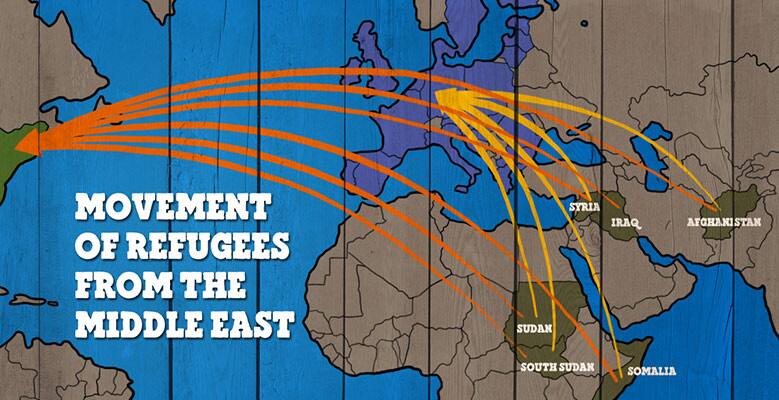December 1, 2016

Back when our co-founders, Jerry and Ben, set up shop in 1978, little could they have imagined that one day their ice cream would be filling freezers all around the globe. But modern technology has made the world smaller, and now we’re all part of one global community, which is great! With a global community comes global responsibilities, and with the intensifying refugee crisis, that’s more evident than ever right now.
Setting Unfortunate Records
Global displacement is off the charts, with more people forced to flee from their homes than ever before in recorded history. The figure stands at a staggering 65.3 million: a country with this population would rank 21st in the world, with more people than either France or the UK. To put it another way, there are nearly twice as many displaced people as there are Canadians.
The figures have taken a sharp upturn in the past five years, having risen almost 21 million from their 2011 levels. So why are we seeing such a dramatic spike in numbers? Like the chocolatey peace signs in Ben & Jerry’s One Love ice cream, the reasons are numerous, but not nearly as appetising.

Syria
The brutal civil war in Syria continues to be by far the largest driving factor. Since the conflict began in 2011, a shocking 4.9 million refugees have been forced to flee Syria, with another 6.6 million internally displaced within the country itself.
Afghanistan & Somalia
Entrenched conflicts, like those in Afghanistan and Somalia, contribute heavily to global refugee numbers: 2.7 million refugees come from the former, and 1.1 million from the latter. Along with Syria, the three countries make up an astonishing 54% of the global refugee population.
New & Reignited Conflicts
Syria makes the most headlines, but sadly there’s no shortage of other global conflicts. According to a recent report by the UNHCR (the UN Refugee Agency) at least 15 have broken out or reignited since 2010. These include wars in Ukraine, South Sudan, Yemen, the Central African Republic, Libya, Mali, Côte d’Ivoire, and Burundi.
The List Goes On…
- Iraq: around 4.4 million internally displaced
- Colombia: 6.9 million internally displaced
- Central America: Tens of thousands fleeing gang and other violence

Learn more and join the fight for human rights here!
A Never-ending Journey
An additional factor in the spiraling levels of global displacement is that it’s taking longer than ever for people to be able to return to their home countries. According to the UNHCR, the average period of displacement for a refugee is now 25 years, meaning that entire generations spend their lives in limbo.
Imaging fleeing home at 15 years old, having your world turned on its head, and returning home at age 40 trying to rebuild your life. The notion is staggering.

Why The Focus On Europe?
Although the media spotlight is on developed nations within Europe, the vast majority of refugees – around 86% – are actually hosted by far less affluent countries. In fact, the world’s five wealthiest countries – the US, China, Japan, Germany, and the UK - host less than 5%. This is a shameful statistic, and one that must change if we hope to solve this crisis.
To look at it another way, only 10 countries host well over half the world’s refugees. Yet between them, these countries make up only 2.5% of the world’s GDP. We are leaving the poorest nations to take the largest brunt of resettlement, which is unacceptable.
Let’s dream a little for a second: if the US accepted a mere tenth as many refugees per capita as, let’s say, Lebanon, nearly 6 million refugees would have a home. If China did the same, that would take care of another 25.3 million. These are the levels or resettlement that must become a reality, and we need our world leaders to act.
Time For Action!
Shockingly, 34,000 people per day are forced to flee their homes by conflict and persecution. Perhaps more shockingly, nearly half of them are children. Sadly, things aren’t going to get better by themselves. If those of us in more developed nations are to live up to our enlightened rhetoric, we really need to step up our efforts. It’s time we lent a hand to the countries that are carrying most of the weight.
Climate change has been a major driving factor in the Syrian conflict, meaning that – in a sense – we’re all jointly responsible. That’s yet another compelling reason (as if we needed one!) not to sit around and hope that someone else will take care of the problem. We all have a moral imperative to do what we can to raise our voices and pressure our governments to act. Sign the petition today, and show that you stand with the millions of refugees around the world!

Learn more and join the fight for human rights here!


